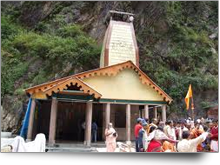
The sacred shrine of Yamunotri, source of the river Yamuna, is the westernmost shrine in the Garhwal Himalayas, perched atop a flank of Bandar Poonch Parvat. The chief attraction atYamunotri is the temple devoted to goddess Yamuna and the holy thermal springs at Jankichatti (7 km. Away).
The actual source a frozen lake of ice & glacier (Champasar glacier also known as Yamunotri Glacier) located on the Kalind mountain at the height of 4421 m above sea level, about 1 km further up, is not frequented generally as it is not accessible and hence the shrine has been located on the foot of the hill. The approach is extremely difficult and pilgrims therefore offer pooja at the temple itself.
The Yamunotri temple is on the left bank of Yamuna constructed by Maharaja Pratap Shah of Tehri Garhwal. The deity is made of black marble. The Yamuna like Ganga has been elavated to the status of divine mother for the Hindus and has been held responsible for nurturing and developing the Indian civilization.
Close to the temple are hot water springs gushing out from the mountain cavities. Suryakund is the most important Kund. Near the Suryakund there is a shila called Divya Shila, which is worshipped before puja is offered to the deity. Devotees prepare rice and potatoes to offer at the shrine by dipping them in these hot water springs, tied in muslin cloth. Rice so cooked is taken back home as prasadam.The pujaris of Yamunotri come from the village of Kharsali near Jankichatti. They are the administrators of the sacred place and perform religious rites well versed in Shastras.
Yamunotri Temple Guide
Yamunotri Temple is open for devotees from 6am to 8pm. Aarti timings of Yamunotri temple is from 6:30 pm and 7:30 pm. The special pooja is organized in Yamunotri on the eves of Janmashtami and Diwali.
Yumnotri in Winter
Kharsali, a village 6 kilometres away, is said to be Yamuna’s mother’s home, and her brother Shani Dev travels up to escort her back to Kharsali. When the temple closes for the season, Yamuna’s doli is taken to Kharsali – with pomp and ritual -- where the pandits and purohits spend the winter months and where she is worshipped for these months.
